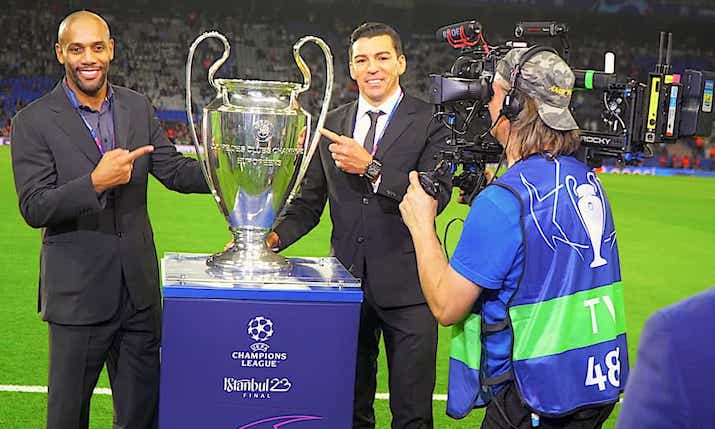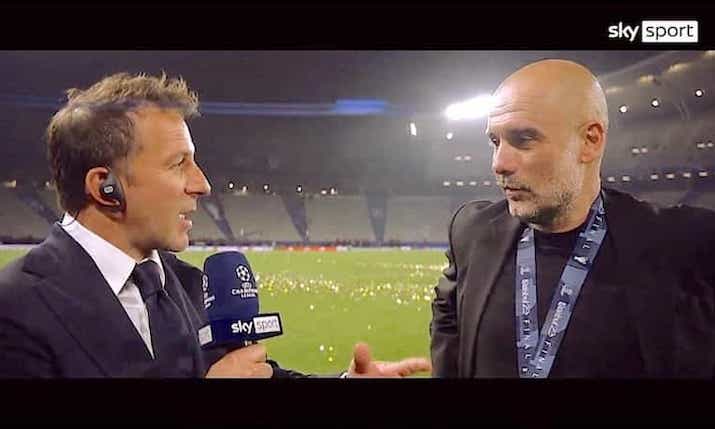Anamorphic lens captures cinematic look for Champions League Final

The anamorphic lens offered a cinematic look
Some 42 cameras were used to capture the action of the 2023 Champions League final, held on Saturday 10 June at the Atatürk Olympic Stadium in Istanbul, including, for the first time in the Champions League, a Sony FX30 camera complete with a portable anamorphic lens.
Host broadcaster for the event was Spain’s MediaPro, while the one-sided customisation for Sky Italia was handled by Cinevideo and directed by Roberto (Popy) Montoli.
The customisation involved filming from within a small studio set high up in the stands as well as from a second pitchside setup, both very crowded spaces. Sky, somewhat against the trend compared to other broadcasters, requested that all the cameras used for the match could provide images with a cinematic cut, and in the field the full-frame Sony FX6 and FX9 were chosen. The production was carried out in P50 UHD.
In addition, Andy Galeazzi, DoP/filmmaker and inventor of the Rocky electronic stabiliser camera mount system for capturing special shots, proposed employing an anamorphic lens for his pre- and post-match shooting.
In the constant search for something more and more spectacular, the idea was appreciated and a Rocky support was applied to a gimbal by hand to transform it into a shoulder camera; a small Sony FX30 video camera was mounted and a new-generation anamorphic adapter was born. This design made it possible to circumvent the heavy weight and high cost associated with anamorphic lenses used in cinematography, which limit their use in television production
“Today, companies are springing up,” says Galeazzi, “which make lightweight optics that are ideal for film-makers and for anamorphic assault shooting, i.e. that are capable of capturing more information on the longitudinal axis and compressing it with an optical squeeze.
“Furthermore, the latest firmware update of the Sony FX30 goes precisely in this direction, since it is able to electronically decompress or ‘de-squeeze’, the aberrations of these lenses.
This makes the use of these new optics perfect as they are able to capture a greater portion of the field in the long focal length in the panoramic angular aperture, that is, horizontally.
“These are lenses with a fixed focal length which, impose some limitations, but it will not be long before we also see light anamorphic lenses in zoom format on the market.”
Reconstructed form
The concept of anamorphic, which derives from the Greek and means ‘reconstructed form’, is borrowed from traditional cinema, where in normal 35mm format it was possible to compress a greater framing space to return a very wide and spectacular image on the screen, through the process of compression and decompression.
Today the output signal from the camera which uses one of these new anamorphic lenses is normalised using a mixed optical and electronic process, and is therefore ready for use in the cinema or in the TV production chain.
“This concept,” says Galeazzi, “has made anamorphic suitable for live productions, given that there is no delay in the output signal. This allows us to propose at least three advantages: the first is that it widens the panorama, or the long shot framed, to include a greater portion of the space, up to 33% more.
“In football this is an advantage as the playing field is wide and using it in a crowded pitch position, as in this case, its allowed for much wider shots.”
He continues: “A second advantage of anamorphic images is a visual effect, that horizontal band, or line of blue/blue light, which is generated in the image when a strong light enters the frame. This gives back a very blockbuster cinema look, making the television image even more spectacular, as in the great movies.
“The third advantage of these light and inexpensive optical adapters is the so-called out-of-focus bokeh, or out-of-focus effect, on the lights and background, which become out-of-round and make the subject in the foreground stand out.
“The latest generation sensors of the small Sony FX3 and FX30 boast such high and pleasant dynamics that many at home have not been able to perceive any differences compared to the images taken by other much more expensive cameras.”

The anamorphic lens used in the Champions League final delivered an aspect ratio of 2.35:1, horizontal blue strikes on the lights and an oval bokeh effect
At the Champions League a 24mm fixed focal length lens from Sirui was used, “but the real step forward will be to use anamorphic zooms, i.e. conventional zooms equipped with a front anamorphic adapter, and we are already testing them in live sports broadcast. The image format is no longer 16:9 but 2.35:1,” he adds.
“As compact anamorphic lenses have become popular with young independent film makers, so the lenses have become lighter and anamorphic adapters for television zoom lenses are already being tested. Where a normal lens would have struggled to capture all the talent in the frame, anamorphic lenses make it possible to make even interviews and commentary spectacular.”

